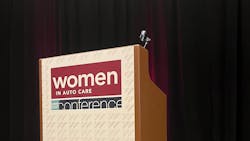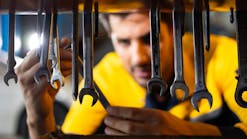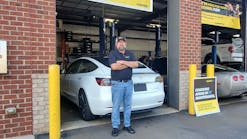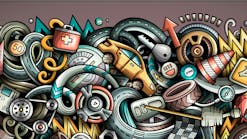The Women in Auto Care Leadership Conference was held Feb. 27 through March 1 in Palm Springs, California. Women in Auto Care is a community of the Auto Care Association. The theme this year for the community's annual event was "Resilient and EmpowHERed," and this was exemplified through the conference's various speakers and their respective sessions.
One such session revolved around the topic of being empowered by information. It was a panel called "Emerging Vehicle Tech: What You Actually Need to Care About." The panelists were Susan Starnes of NAPA Auto Parts, Meagan Moody of ZF Aftermarket, and Carolyn Coquillette of Luscious Garage (now Earthling Automotive) and Shop-Ware. The panel was moderated by Stacey Miller, vice president of communication for the Auto Care Association.
Although conference attendees came from across the automotive industry, the purpose of the panel was to shed light on aspects of vehicle electrification and ADAS that impact all corners of the industry.
According to data from a slide deck featured alongside the panelists, there are only 20 moving parts in an EV drivetrain versus 200 in a traditional drivetrain, and there are approximately 15,000 total parts in an EV versus 30,000 total parts in an ICE car.
To understand the full impact of these elements and more, all of the panelists agreed that seeking out information and educational opportunities is key.
Understand the Context
As the vice president of emerging markets for NAPA Auto Parts, Starnes works with elements of new vehicle technology. On the panel, she pointed out that you simply don't know what you don't know.
"For EVs and ADAS really, it's about education and understanding," Starnes said.
Starnes mentioned that at NAPA, their team is working to navigate and get ahead of emerging technology. This includes developing and understanding of what the specific training needs are for these newer vehicles.
Keeping all of the change that's happening in mind, it was also pointed out on the slide deck that the average age of vehicles on the road these days is 12 years. Moody pointed to another important detail to consider. Moody is the head of customers and strategy, North America, aftermarket, for ZF Group.
"If our cars aren't failing earlier, then we're probably going to tend to keep our cars longer," Moody said.
Moody noted that there will continue to be big pockets of the country, such as California, that will adopt electric vehicles fervently. But the rural areas of the United States will not take on these new vehicles at the same rate and they cannot be overlooked.
Coquillette is the founder of Shop-Ware, which is an automotive shop software. She opened Luscious Garage 16 years ago and started working on hybrid cars before they became more mainstream in the car parc.
As for EVs, she said on the panel that the industry is still in the early days of seeing them break. She said that tires and some undercar services are a couple of examples of EV repairs being conducted.
"Our expectation with EVs is that we're going to have to be patient and learn more about them," Coquillette said.
Considering many new electric vehicles are still under warranty, Coquillette said independent shops still have an opportunity for service because people will look for alternative options when they are unhappy with a dealership. She said access to information and parts is important in these repairs and it's helpful when EV automakers are cooperative with information.
As more change comes with the technology on new vehicles, Coquillette said the aftermarket has the opportunity to step up, lean in, learn more, and provide solutions.
"Self-driving cars aren't going to be self-fixing cars," Coquillette said.
Fill the Toolbox
On the topic of fixing, all of the panelists agreed that proper tools are crucial to understanding emerging vehicle technology. Starnes said on the EV side, this involves a lot of safety tools such as gloves and diagnostics equipment. For ADAS, it's about the calibrations and making sure you have the right machine for the vehicle in question.
Coquillette said that the kinds of high voltage tools used in hybrid repair could be transferrable to some services being conducted on EVs. Moody mentioned the importance of recognizing the prevalence of things like over-the-air updates that have become more commonplace on newer vehicles.
The panelists also discussed the topic of liability for when things go wrong with repairing technologically advanced vehicles. Starnes said that it may take a few court cases to determine the best courses of action going forward with this complex topic.
Moody said that one roadblock to consider is that there are some A-level shops doing great work with these vehicles, but there are many B and C level shops out there that may not be as up to date on electrification information, which may impact their repair approach.
Coquillette said manufacturers need to make cars that are safe to work on and that, "the car needs to be serviceable, and the car needs to be safe." She said the burden placed on service providers to conduct safe repairs is not new and it will separate the shops that are able to do it well and those that are not.
"This is not our first rodeo," Coquillette said.
Overall, Miller listed some of the main takeaways from the panel discussion as investing in training and education, not being intimidated by emerging technologies by investing in tools and equipment and having a willingness to work with retail partners and manufacturers.






